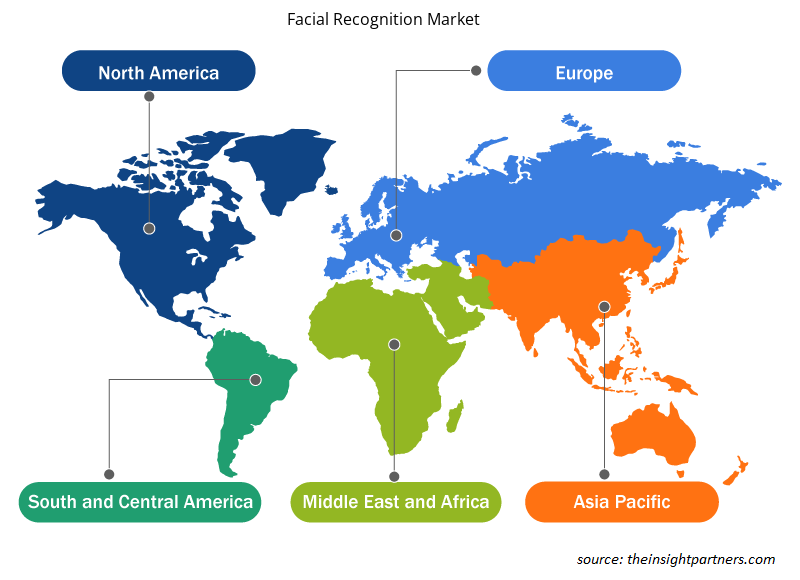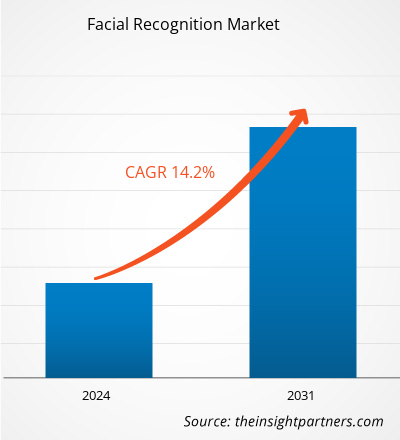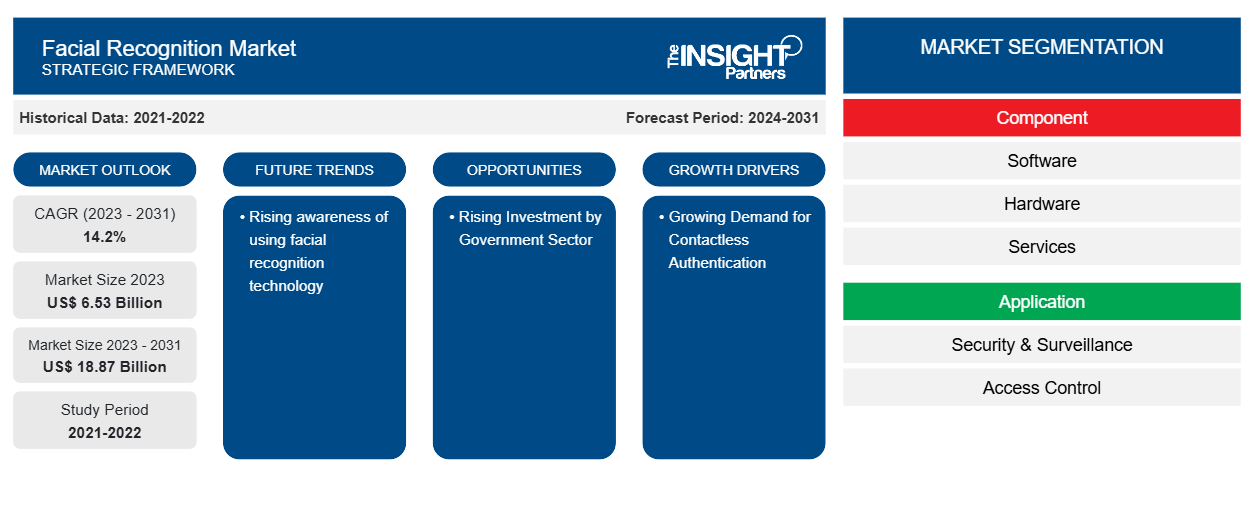La taille du marché de la reconnaissance faciale devrait atteindre 18,87 milliards de dollars américains d'ici 2031, contre 6,53 milliards de dollars américains en 2023. Le marché devrait enregistrer un TCAC de 14,2 % au cours de la période 2023-2031.La sensibilisation croissante à l’utilisation de la technologie de reconnaissance faciale devrait rester une tendance clé du marché.
Analyse du marché de la reconnaissance faciale
La demande croissante de systèmes de vidéosurveillance efficaces entraîne une hausse de la demande de technologies de reconnaissance faciale. La technologie de reconnaissance faciale est adoptée par des secteurs tels que la sécurité et l'application de la loi, la santé, la vente au détail et les transports pour améliorer la sécurité et la sûreté.
Aperçu du marché de la reconnaissance faciale
La reconnaissance faciale est un type de logiciel biométrique qui utilise les traits du visage d'une personne pour vérifier son identité. La reconnaissance faciale est une méthode typique utilisée dans les systèmes de sécurité pour identifier des personnes ou des utilisateurs spécifiques. L'une des applications les plus fréquentes de la reconnaissance faciale est le déverrouillage des téléphones portables. Cette technique est également utilisée dans les opérations de police, la surveillance vidéo et le contrôle des passagers. La reconnaissance faciale cartographie mathématiquement les caractéristiques faciales d'une personne et stocke les résultats sous forme d'empreinte faciale. Pour valider l'identification d'un individu, le programme compare une vidéo ou une image numérique distincte à une base de données d'empreintes faciales stockées à l'aide de techniques d'apprentissage profond.
Personnalisez ce rapport en fonction de vos besoins
Vous bénéficierez d'une personnalisation gratuite de n'importe quel rapport, y compris de certaines parties de ce rapport, d'une analyse au niveau des pays, d'un pack de données Excel, ainsi que de superbes offres et réductions pour les start-ups et les universités.
-
Obtenez les principales tendances clés du marché de ce rapport.Cet échantillon GRATUIT comprendra une analyse de données, allant des tendances du marché aux estimations et prévisions.
Facteurs moteurs et opportunités du marché de la reconnaissance faciale
La demande croissante d'authentification sans contact devrait favoriser le marché
Le besoin croissant de techniques d'authentification sans contact, ainsi que la disponibilité de caméras haute résolution et l'utilisation croissante de smartphones équipés de fonctions de reconnaissance faciale, propulsent le secteur de la reconnaissance faciale vers l'avant. Cette technologie est utilisée dans de nombreux secteurs, notamment la surveillance, la banque, les aéroports et le contrôle d'accès . On estime que le marché génère des revenus importants et continuera de croître dans les années à venir.
Hausse des investissements du secteur public
Le secteur gouvernemental comprend diverses installations gouvernementales, installations de défense, municipalités, stations de services publics et autres. En raison de l'importance croissante accordée à la sécurité nationale, les gouvernements du monde entier investissent considérablement dans des solutions de sécurité avancées telles que les systèmes de reconnaissance faciale. En outre, l'accent croissant mis sur le développement de villes intelligentes fait partie des autres facteurs contribuant à l'adoption de systèmes de reconnaissance faciale pour des applications de sécurité et de surveillance améliorées, ce qui stimule la croissance du marché de la reconnaissance faciale.
Analyse de segmentation du rapport sur le marché de la reconnaissance faciale
Les segments clés qui ont contribué à l’élaboration de l’analyse du marché de la reconnaissance faciale sont les composants, les applications et les secteurs verticaux.
- En fonction des composants, le marché est segmenté par logiciels, matériels et services. Le segment du matériel détenait une part de marché importante en 2023.
- En fonction des applications, le marché est segmenté en sécurité et surveillance, contrôle d'accès et autres. Le segment de la sécurité et de la surveillance détenait une part de marché plus importante en 2023.
- Sur la base de la verticale, le marché est segmenté en BFSI, commerce de détail et e-commerce, gouvernement, santé, éducation, automobile et transport, et autres. Le segment BFSI détenait la plus grande part du marché en 2023.
Analyse des parts de marché de la reconnaissance faciale par zone géographique
La portée géographique du rapport sur le marché de la reconnaissance faciale est principalement divisée en cinq régions : Amérique du Nord, Asie-Pacifique, Europe, Moyen-Orient et Afrique, et Amérique du Sud et centrale.
L'Amérique du Nord a dominé le marché en 2023. Par conséquent, tout impact sur la croissance des industries devrait avoir un impact négatif sur la croissance économique de la région. Malgré plusieurs réglementations étatiques et locales régissant la technologie de reconnaissance faciale aux États-Unis, des conflits imminents persistent. La reconnaissance faciale devrait augmenter considérablement dans les années à venir en raison de l'augmentation des investissements et de l'enthousiasme des entreprises à l'adopter. Dans le même temps, les législateurs américains et les groupes de protection de la vie privée expriment leurs inquiétudes quant aux effets sociétaux potentiels de la technologie et plaident en faveur d'une réglementation plus stricte.
Aperçu régional du marché de la reconnaissance faciale
Les tendances régionales et les facteurs influençant le marché de la reconnaissance faciale tout au long de la période de prévision ont été expliqués en détail par les analystes d’Insight Partners. Cette section traite également des segments et de la géographie du marché de la reconnaissance faciale en Amérique du Nord, en Europe, en Asie-Pacifique, au Moyen-Orient et en Afrique, ainsi qu’en Amérique du Sud et en Amérique centrale.

- Obtenez les données régionales spécifiques au marché de la reconnaissance faciale
Portée du rapport sur le marché de la reconnaissance faciale
| Attribut de rapport | Détails |
|---|---|
| Taille du marché en 2023 | 6,53 milliards de dollars américains |
| Taille du marché d'ici 2031 | 18,87 milliards de dollars américains |
| Taux de croissance annuel composé mondial (2023-2031) | 14,2% |
| Données historiques | 2021-2022 |
| Période de prévision | 2024-2031 |
| Segments couverts |
Par composant
|
| Régions et pays couverts |
Amérique du Nord
|
| Leaders du marché et profils d'entreprises clés |
|
Densité des acteurs du marché de la reconnaissance faciale : comprendre son impact sur la dynamique des entreprises
Le marché de la reconnaissance faciale connaît une croissance rapide, tirée par la demande croissante des utilisateurs finaux en raison de facteurs tels que l'évolution des préférences des consommateurs, les avancées technologiques et une plus grande sensibilisation aux avantages du produit. À mesure que la demande augmente, les entreprises élargissent leurs offres, innovent pour répondre aux besoins des consommateurs et capitalisent sur les tendances émergentes, ce qui alimente davantage la croissance du marché.
La densité des acteurs du marché fait référence à la répartition des entreprises ou des sociétés opérant sur un marché ou un secteur particulier. Elle indique le nombre de concurrents (acteurs du marché) présents sur un marché donné par rapport à sa taille ou à sa valeur marchande totale.
Les principales entreprises opérant sur le marché de la reconnaissance faciale sont :
- Tech5
- IDÉMIA
- Conscient Inc.
- Cognitec Systems GmbH
- Société Ayonix
- Fujitsu Limitée
Avis de non-responsabilité : les sociétés répertoriées ci-dessus ne sont pas classées dans un ordre particulier.

- Obtenez un aperçu des principaux acteurs du marché de la reconnaissance faciale
Actualités et développements récents du marché de la reconnaissance faciale
Le marché de la reconnaissance faciale est évalué en collectant des données qualitatives et quantitatives après des recherches primaires et secondaires, qui comprennent d'importantes publications d'entreprise, des données d'association et des bases de données. Quelques-uns des développements du marché de la reconnaissance faciale sont énumérés ci-dessous :
- IDEMIA a dévoilé VisionPass SP, sa dernière solution de reconnaissance faciale pour le contrôle d'accès. IDEMIA enrichit son offre de produits avec VisionPass SP, un terminal élégant et compact au design écologique qui fournit des résultats de comparaison précis et équitables. (Source : IDEMIA, Communiqué de presse, janvier 2024)
- BAXE et Haventec se sont associés à IDEMIA pour lancer le premier écosystème blockchain utilisant une solution d'authentification faciale pour l'identification. (Source : BAXE, Communiqué de presse, janvier 2022)
Rapport sur le marché de la reconnaissance faciale : couverture et livrables
Le rapport « Taille et prévisions du marché de la reconnaissance faciale (2021-2031) » fournit une analyse détaillée du marché couvrant les domaines ci-dessous :
- Taille et prévisions du marché de la reconnaissance faciale aux niveaux mondial, régional et national pour tous les segments de marché clés couverts par le champ d'application
- Tendances du marché de la reconnaissance faciale ainsi que la dynamique du marché telles que les facteurs déterminants, les contraintes et les opportunités clés
- Analyse détaillée des cinq forces de PEST/Porter et SWOT
- Analyse du marché de la reconnaissance faciale couvrant les principales tendances du marché, le cadre mondial et régional, les principaux acteurs, les réglementations et les développements récents du marché
- Analyse du paysage industriel et de la concurrence couvrant la concentration du marché, l'analyse de la carte thermique, les principaux acteurs et les développements récents pour le marché de la reconnaissance faciale
- Profils d'entreprise détaillés
- Analyse historique (2 ans), année de base, prévision (7 ans) avec TCAC
- Analyse PEST et SWOT
- Taille du marché Valeur / Volume - Mondial, Régional, Pays
- Industrie et paysage concurrentiel
- Ensemble de données Excel
Rapports récents
Rapports connexes
Témoignages
Raison d'acheter
- Prise de décision éclairée
- Compréhension de la dynamique du marché
- Analyse concurrentielle
- Connaissances clients
- Prévisions de marché
- Atténuation des risques
- Planification stratégique
- Justification des investissements
- Identification des marchés émergents
- Amélioration des stratégies marketing
- Amélioration de l'efficacité opérationnelle
- Alignement sur les tendances réglementaires























 Obtenez un échantillon gratuit pour - Marché de la reconnaissance faciale
Obtenez un échantillon gratuit pour - Marché de la reconnaissance faciale